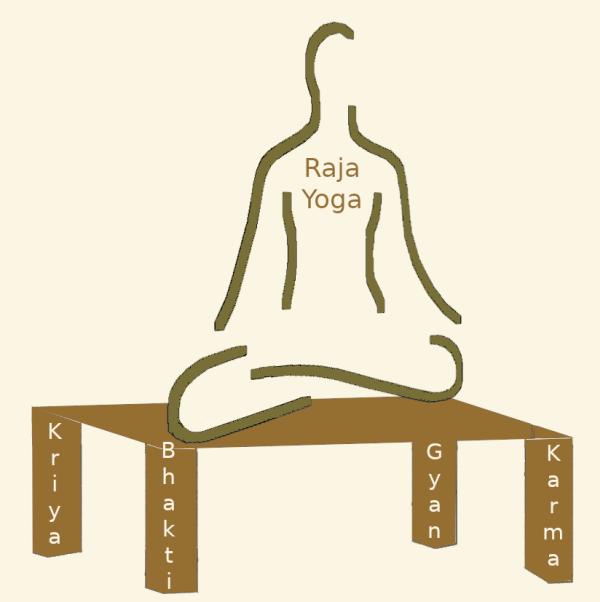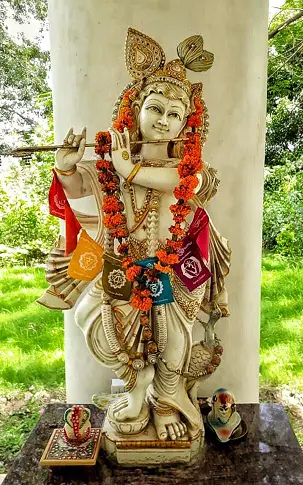Everyone is different, (that’s why we’re called individuals) and it’s completely up to each individual which path they choose to follow.
You are a combination of body, mind, energy, and emotions, and for you to feel aligned with something higher you have to do something that makes your soul sing.
For this reason, yoga is divided into four main paths (with various subcategories in each but we won‘t go into that for now).
| BhaktiYoga | – Becoming unquestioningly devoted to the divinity within or without |
| KriyaYoga | – (Internal Action) Working with your internal energy to transcend (Asana yoga comes in this category) |
| KarmaYoga | – (Outward Action) Service, and bringing yoga into all of your actions |
| GyanYoga | – Using knowledge to reach the ultimate truth, by removing illusions |
| RajaYoga | – A pick ‘n’ mix, combining various aspects of the other four paths |

Gyan Yoga
Gyan (sometimes written jnana due to difficulty in transliteration) means knowledge. The path is less to do with factual information that you can memorize (although it may start like that), and more about deep knowledge. As in the way you know how to turn on all of your body systems when you wake up, but you may not intellectually know how to do the processes.
The yoga of knowledge is a deep inquiry into the truth of life, the self, the divine, and the universe. This type of inquiry requires more than just the intellect, you must include the inner mind and heart.
The state of Gyan or knowing is one in which you are clearly awake and aware of the world as it is, as distinct from the world as it is described or as you expect it to be. In the state of ‘knowing’ or clarity you no longer need to keep thinking, talking, figuring, symbolizing, and making analogies for what is going on, you are simply aware and able to observe and absorb. It turns into a state not of thought but of perception. An example of this could be someone like Isaac Newton. In early life completely fascinated with how the world works, and why things happen. He made great advancements in the understanding of people in relation to the world they live in. In later life, he became obsessed with alchemy, and experimentation with potions with magical properties. In whatever he did he was driven by the idea of truth as an absolute and followed this path to his death.
Bhakti Yoga
Bhakti means devotion. The yoga of devotion is the path of belief. It is unconditional and unquestioning love and worship of the divine as the ultimate reality, both externally and internally. The image or concept of your devotion is relatively unimportant (you can choose any deity, guru, or concept you like) but it is enlightenment through the act of being completely devoted.

You can consider Christianity as a form of bhakti-yoga because it is yoga practiced through extreme reverence and love for some being felt more or less external to oneself, who is the representative of the divine.
In Hinduism, devotional practice consists of rituals (puja), devotional songs (kirtans), chanting (japa), and meditation on the divine (upasana). But people who follow any spiritual or religious path fully and with sincerity can reach enlightenment/moksha/satori/heaven/yoga/bliss etc whatever name you choose to give it.
This is the path of devotion and is suitable for the people who are heart oriented. It is said that one reaches enlightenment much faster through a devoted heart than through any other way. Followers of Krishna are Bhakti yogis. In Bhakti yoga the Bhagvan (god) or Guru (enlightened master) and Bhaktaa (devotee) are important. This path is a path of surrender. In all situations, the devotee‘s ability to feel surrendered to their Guru and God liberates them from ignorance and moves them towards the truth. In Bhakti yoga, physical asana practice and breathing techniques are not so important. They sing and dance out of joy and appreciation and also they mourn in Virah (separation) to express their deep desire to be one with God. While worshiping God and tending to their Guru, they practice Karma (doing) Yoga.
Karma Yoga
Karma means outward action, and incidentally, that is all it means. It has nothing to do with the law of cause and effect. When we say that something that happens to you is your karma, all we are saying is that it is your own doing. Nobody is in charge of karma except you. So Karma yoga is the way of action, of using everyday life, your trade, chores, interests, or obligations as your way of yoga, and as your way of discovering who you are.
Karma yoga also includes service to others (‘seva‘ in sanskrit). Which might consist of providing food, and clothing to the poor, working in schools, hospitals, and distributing books and teachings. This is not only limited to people but also to animals, plants, and the planet.
Karma yoga is being able to reach a point where you are no longer the do-er but you are an instrument through which things are being done, and through this, you reach your clarity.
Karma Yoga means that every action is done with meditative/ mindful awareness. In Karma yoga, practicing asana or yoga is not important but doing any work selflessly and without seeking the results. Certain people are very active and cannot be still, for these souls, Karma Yoga suits their spiritual path. This is the beauty of many paths that lead towards the same goal, the realization of one‘s own true nature.
Kriya Yoga
Kriya means internal action. It refers to an action, process, or movement, that brings about mental and physical transformation so that we are ready for deep meditation which will lead us to yoga. The Hatha Yoga that we practice is a type of Kriya Yoga.
According to Patanjali, Kriya yoga consists of three types of actions;
Tapah (self-discipline) Tap means heat, In this system, you do certain techniques which might include postures, pranayama, etc to increase heat or energy which is lying dormant in you. once this energy is awakened then it will automatically start doing its work by fixing your whole body, removing ‘burning through’ any kind of blockages (both physical and mental). Sometimes it might come as an emotional release like anger sadness, or crying but gradually it will get resolved and dissolved.
Swadhyaya (self-study) You look inside, find and remove all those things you are not. You evaluate and release everything which is clouding reality. Gradually seeing through social-cultural and personal conditioning. It includes finding your swadharma (your purpose in this world).
Ishwarapranidhana (surrender to the divinity within) You are not the doer, you are just an instrument through which the divine inside you is doing everything.
Raja yoga
Raja means kingly or royal. It is not so much a category of its own but the combination of some or all of the other four types of yoga. For anyone trying to reach liberation (whatever name they might put on it) being able to do this by following only one path is rare. The majority of people will gradually include the aspects of other yoga which appeal to and make sense to them.
Next Chapter>> What is Hatha Yoga
Yoga For Beginners – Guidelines <<Previous Chapter